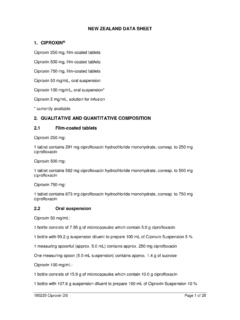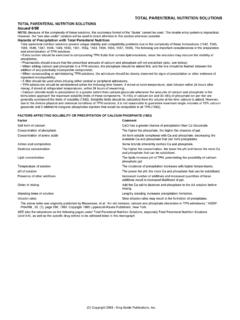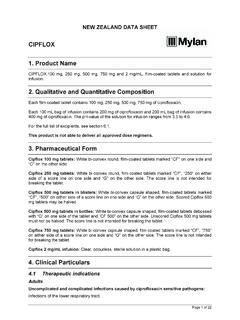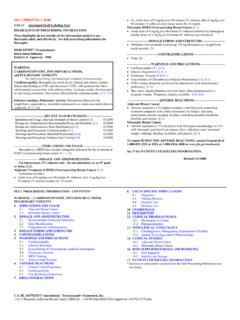Transcription of PRODUCT INFORMATION RINGER’S SOLUTION FOR …
1 PI ringer s SOLUTION IV infusion 26 Mar 2015 (RSI 20120719) Page 1 of 8 PRODUCT INFORMATION ringer S SOLUTION FOR INTRAVENOUS infusion NAME OF THE MEDICINE Composition: the ingredients in ringer s SOLUTION for Intravenous infusion ( ringer s SOLUTION ) comprise sodium chloride ( g/L), potassium chloride ( g/L) and calcium chloride dihydrate ( g/L) in Water for Injections. Hydrochloric acid and/or sodium hydroxide may be added for pH adjustment. Chemical name Molecular structure Molecular mass CAS number sodium chloride NaCl potassium chloride KCl 7447-40-7 calcium chloride (dihydrate) CaCl2,2H2O 147 10035-04-8 DESCRIPTION Potassium chloride and sodium chloride occur as a colourless or white crystal and are freely soluble in water. Calcium chloride is a white, crystalline powder, hygroscopic and freely soluble in water.
2 ringer s SOLUTION is sterile and non-pyrogenic. There is no antimicrobial agent or buffer added. They are isotonic intravenous solutions with pH of and an osmolarity of 308 mOsmol/L. PHARMACOLOGY Pharmacodynamics: ringer s SOLUTION is an isotonic SOLUTION of electrolytes. The constituents of ringer s SOLUTION and their concentrations are designed to match those of plasma. The pharmacodynamic properties of this SOLUTION are those of its components (water, sodium, potassium, calcium, and chloride). The main effect of ringer s SOLUTION for is the expansion of the extracellular compartment including both the interstitial and intravascular fluids. Ions, such as sodium, circulate through the cell membrane using various mechanisms of transport among which is the sodium pump (Na-K-ATPase). Sodium plays an important role in neurotransmission and cardiac electrophysiology, and also in its renal metabolism.
3 Potassium is essential for numerous metabolic and physiological processes including nerve conduction, muscle contraction, and acid-base regulation. A normal concentration of potassium in plasma is about to mmoles per litre. Potassium is predominantly an intracellular cation, primarily found in muscle; only about 2% is present in the extracellular PI ringer s SOLUTION IV infusion 26 Mar 2015 (RSI 20120719) Page 2 of 8 fluid. The passage of potassium into the cells and retention against the concentration gradient requires active transport via the Na+/K+ ATPase enzyme. Approximately 99% of calcium is incorporated into the skeleton. The remaining 1% is found in body tissues and fluids, and is essential for normal nerve conduction, muscle activity, and blood coagulation. Chloride is mainly an extracellular anion found in low concentration in bone and in high concentration in some components of connective tissue such as collagen.
4 Intracellular chloride is in high concentration in red blood cells and gastric mucosa. The balance of anions and cations are regulated by the kidneys. Reabsorption of chloride generally follows reabsorption of sodium. Pharmacokinetics The pharmacokinetic properties of this SOLUTION are those of its components (sodium chloride, potassium chloride, and calcium chloride). The volume and the ionic composition of the extracellular and the intracellular compartments are as follows: Extracellular fluid: approximately 19 litres Sodium (mmol/L): 142 Potassium (mmol/L): 5 Calcium (mmol/L): Chloride (mmol/L): 103 Intracellular fluid: approximately 23 litres Sodium (mmol/L): 15 Potassium (mmol/L): 150 Calcium (mmol/L): 1 Chloride (mmol/L): 1 After injection of radiosodium (24Na), the half life is 11 to 13 days for 99% of the injected Na and one year for the remaining 1%.
5 The distribution varies according to tissues: it is fast in muscles, liver, kidney, cartilage and skin; it is slow in erythrocytes and neurones; it is very slow in the bone. Sodium is predominantly excreted by the kidney, but there is extensive renal reabsorption. Small amounts of sodium are lost in the faeces and sweat. Factors influencing potassium transfer between intracellular and extracellular fluid such as acid-base disturbances can distort the relationship between plasma concentrations and total body stores. Potassium is excreted mainly by the kidneys; it is secreted in the distal tubules in exchange of sodium or hydrogen ions. The capacity of the kidneys to conserve potassium is poor and some urinary excretion of potassium continues even when there is severe depletion. Some potassium is excreted in the faeces and small amounts may also be excreted in sweat.
6 The concentration of calcium in plasma is regulated by parathyroid hormone, calcitonin, and vitamin D. About 47% of calcium in plasma is in the ionised physiologically active form, about 6% is complexed with anions such as phosphate or citrate, and the remainder is bound to proteins, principally albumin. If the plasma-albumin concentration is raised (as in dehydration) or reduced (as is common in malignancy) it will affect the proportion of ionised calcium. Thus, the total plasma-calcium concentration is commonly adjusted for plasma albumin. Excess of calcium is predominantly excreted renally. Unabsorbed calcium is eliminated in the faeces, together with that secreted in the bile and pancreatic juice. Minor PI ringer s SOLUTION IV infusion 26 Mar 2015 (RSI 20120719) Page 3 of 8 amounts are lost in the sweat, skin, hair, and nails.
7 Calcium crosses the placenta and is distributed into breast milk. INDICATIONS ringer s SOLUTION is indicated for restoring the loss of water and electrolytes as required by the clinical condition of the patient. CONTRAINDICATIONS ringer s SOLUTION is contraindicated in patients with: - Extracellular hyperhydration or hypervolaemia - Hypertonic dehydration - Hyperkalaemia - Hypernatraemia - Hypercalcaemia - Hyperchloraemia. - Severe renal insufficiency (with oliguria/anuria). - Uncompensated cardiac failure - Severe hypertension - General oedema and ascitic cirrhosis - Concomitant digitalis therapy (see Interactions with other Medicines). As for other calcium-containing infusion solutions , concomitant treatment with ceftriaxone and ringer s SOLUTION is contraindicated in newborns ( 28 days of age), even if separate infusion lines are used (risk of fatal ceftriaxone calcium salt precipitation in the neonate s bloodstream).
8 PRECAUTIONS High volume infusion must be used under specific monitoring in patients with cardiac or pulmonary failure. solutions containing sodium chloride should be administered with caution to patients with hypertension, heart failure, peripheral or pulmonary oedema, impaired renal function, pre-eclampsia, aldosteronism or other conditions or treatment ( corticoids/steroids) associated with sodium retention (see Interactions with other Medicines). solutions containing potassium salts should be administered with caution to patients with cardiac disease, or conditions predisposing to hyperkalaemia such as renal or adrenocortical insufficiency, acute dehydration, or extensive tissue destruction as occurs with severe burns. Because of the presence of calcium: care should be taken to prevent extravasation during intravenous infusion the SOLUTION should be given cautiously to patients with impaired renal function or diseases associated with elevated vitamin D concentrations such as sarcoidosis in case of concomitant blood transfusion, the SOLUTION must not be administered via the same infusion set because of the risk of coagulation.
9 PI ringer s SOLUTION IV infusion 26 Mar 2015 (RSI 20120719) Page 4 of 8 ringer s SOLUTION contains insufficient concentration of potassium and calcium to be used for maintenance of these ions or to correct their deficits. Hence, after dehydration is treated, the IV fluid has to be changed to a maintenance fluid that will provide these ions. During long-term parenteral treatment, a convenient nutritive supply must be given to the patient. Ceftriaxone Interaction In patients older than 28 days (including adults), ceftriaxone must not be administered simultaneously with intravenous calcium-containing solutions , including ringer s SOLUTION , through the same infusion line ( , via a Y-connector). If the same infusion line is used for sequential administration, the line must be thoroughly flushed between infusions with a compatible fluid.
10 Use in pregnancy ringer s SOLUTION may be used during pregnancy as long as the electrolyte and fluid balance is controlled. However, the potential risks and benefits for each specific patient should be carefully considered before using ringer s SOLUTION in pregnant women. When a medicinal PRODUCT is added to ringer s SOLUTION , the nature of the drug and its use during pregnancy have to be considered separately. Use in lactation ringer s SOLUTION may be used during lactation as long as the electrolyte and fluid balance is controlled. However, the potential risks and benefits for each specific patient should be carefully considered before using ringer s SOLUTION in lactating women. When a medicinal PRODUCT is added to ringer s SOLUTION , the nature of the drug and its use during lactation have to be considered separately. Paediatric Use The use of ringer s SOLUTION in paediatric patients should be based on clinical practice.
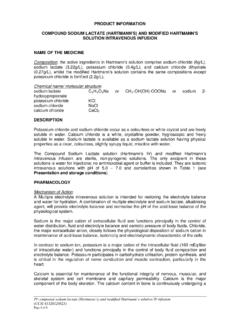
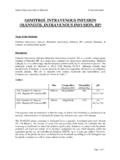
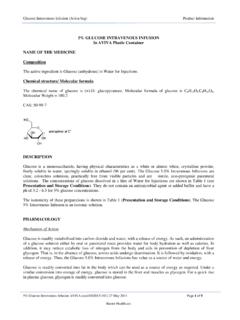
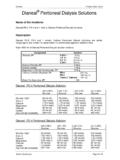
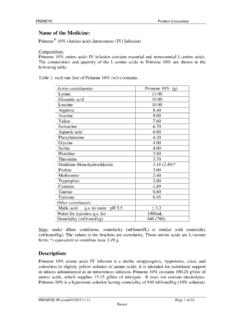
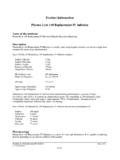
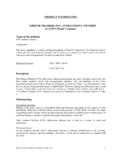
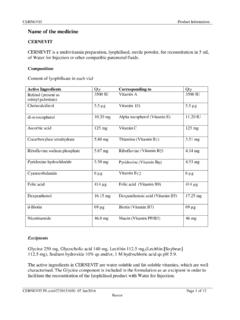

![T I S S E E L [Fibrin Sealant] - Baxter Healthcare](/cache/preview/5/e/c/8/3/b/b/2/thumb-5ec83bb2d349410260af6c556ae67fe3.jpg)
